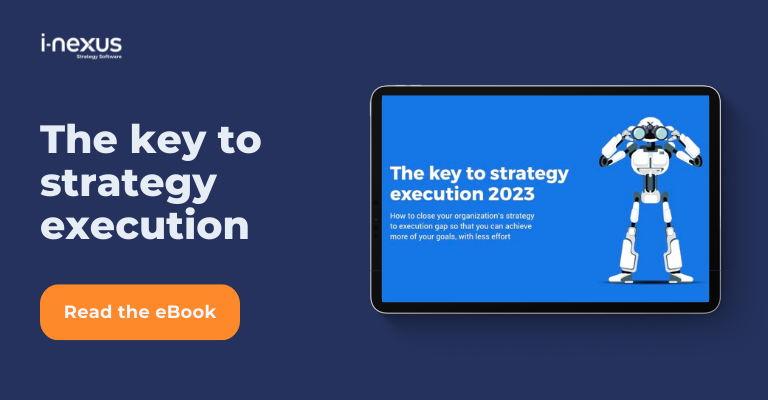The principles of sound Strategy Execution have never been more important than now. During times of change and turbulence, it can help you to navigate the quickly evolving landscape and stay ahead of the game. These are five thoughts for keeping your Strategy Execution on track during COVID-19.
Written by: Steve Kerr, Marketing Campaign Manager
Strategy Execution can put an organization on the competitive map, but more importantly, keep it there.
As this crisis unfolds, some organizations will be resilient. For some, this uncertainty will impact their businesses like never before. The actions of executives and their teams now, will significantly determine their future.
Many businesses have been impacted hard by COVID-19, however, others (such as medical, food and cleaning – and of course toilet roll companies!) are experiencing unprecedented growth. In all instances, businesses are under pressure to execute fast.
The first thing we want to say from everyone here at i-nexus is that our thoughts are with you, your family, your team members and your communities.
Whilst we can't answer how your industry will be impacted in the longer term and what it will mean for your organization and your employees, we can share with you some thoughts to keep your strategy on track during these uncertain times.
We hope that this blog provides some genuinely useful information that helps you to keep your strategic goals on track as your business adapts to virtual working policies, changes in demand, supply chain complexities and more. Much of these ideas are being implemented here at i-nexus.
Here are five thoughts to help keep your Strategy Execution on track during COVID-19.
1. You may need to course correct
We don’t need to say that COVID-19 is causing unprecedented changes to industries and economies. Course correction is all about righting the ship and weathering the storm. The idea is that a strategic plan adapts to failure and overcomes unexpected obstacles. What’s more, it can involve plotting a completely new course for your business.
Hoshin Kanri is one methodology for planning, executing and tracking a strategy and one of the key steps involves reviewing results and take course correction where necessary.
What is Hoshin Kanri? Find out here.
During this time, businesses need to be more agile than ever before. Adaptability will be key to growth and survival. Agility and adaptability will help you to learn from this crisis and react to movement in the market.
Here are some businesses who have already course corrected:
- Brewdog
A Scottish craft brewer quickly began making hand sanitizer amid shortages in UK.
- Dyson
Dyson has worked with the UK government and The Technology Partnership to design a ventilator and intends to start production of ventilators amid global shortages.
- Mercedes Formula 1 Team
Is developing a new UK breathing aid for COVID-19 patients. - Pubs
Many local pubs and restaurants have opened home delivery services and have been inundated with orders from vulnerable people self-isolating. - Gyms
Gyms and personal trainers across the world have started live streaming exercise classes so they can still add value for their customers whilst people stay at home. - Louis Vuitton
Have repurposed their fragrance factories to make hand sanitizer.
2. Keep your teams aligned
Almost overnight, because of COVID-19, offices closed and critical employees are now working remotely. It is crucial that you maintain alignment in the new remote environment.
Leaders need to keep everyone connected, aligned and ensure the business is moving forward.
Tools such as Zoom, Skype for Business, Slack and Microsoft Team can help with this.
Mandatory daily video conferencing calls at the same time every day have been widely adopted. These are useful to keep teams in touch and share their social situation, how they’re doing or just to maintain that human element of work.
These are also the ideal forum for situational updates, plan reviews, problem solving and further discussions. Then you need to ensure that key information is cascaded throughout the organization to make sure that everyone is on the same page and engaged.
3. Relentlessly focus on your vision
“Focus on the wildly important” is one of Franklin Covey’s 4 Disciplines of Execution.
Covey’s research has shown that only 15 percent of employees actually know their organization’s most important goals—either there are no goals or they have too many goals.
Those organizations that survive will be those with structured Strategy Execution plans and business systems. These companies have an aligned business strategy and have mobilized the entire organization towards their business strategy. They also are clear on the performance metrics. This vision enables smarter leadership.
During COVID-19 the best organizations will decide what strategic items to keep, which to adjust and which to cancel. Initiatives that fall outside of scope should be cancelled to free up bandwidth and to enable you to focus on the key initiatives that will help you weather this storm.
"Focusing on the wildly important requires you to go against your basic wiring as a leader to do more, and instead, focus on less so that your team can achieve more."
Sean Covey, Co-Author of the 4 Disciplines of Execution
4. Step up and lead – don’t fall into your operational comfort zone
It is easy to go into panic mode and make quick decisions to manage your response. The danger is that leaders return to their operational comfort zone. You may feel that you are adding tangible value, but you will rarely take a longer-term view whilst focusing on the present crisis.
Covey’s research also shows that 70% of strategic failures are due to poor execution of leadership.
Crises, fraught with complex change, require executives to both effectively lead AND manage. Whilst managing involves address the urgent present need, to make quick decisive decisions and sufficiently allocate resources, leading involves guiding people to the best possible outcome. Leading requires a focus on what will come next and creating a readiness to meet it. This means seeing beyond the immediate crisis to anticipate the future plan.
The best leaders will be anticipating what is coming next week, next month and next year and course correcting the organization for the incoming changes. They will delegate, trust and provide support as their people as they make decision.
5. Have a Strategy Execution System
COVID-19 will see new strategic plans emerge as organizations adjust and course correct. As you formulate a new strategic plan, you must focus on creating as an executable plan. In our view, Hoshin Kanri is one of the best ways to plan an executable strategy in a single page document that includes goals, strategies, initiatives and owners.
Hoshin Kanri – sometimes known as Hoshin Planning, Policy, Goal or Strategy Deployment – is a strategic planning process whereby strategic goals are communicated and translated into action.
Originating in Japan in the 1950s and now being adopted worldwide as the de facto Strategy Execution methodology, Hoshin Kanri means ‘compass management’ and serves to align the entire organization’s resources and actions with management’s strategic goals.
There are seven-steps to Hoshin Kanri:
- Setting the True North (a Vision)
- Developing Breakthrough Objectives
- Annual Objectives and Improvement Priorities
- Catchball
- Implementing Annual Objectives
- Monthly (and Quarterly) Reviews
- Annual Reviews
In these unprecedented times, you may be wondering why you should talk about planning, maps and direction. We are in uncharted territory, right?
However, it is in conditions like these that tight control of both planning and execution is necessary to both survive and thrive.
It is in times like these that your whole organization needs to pull together, committed to a method, moving in the same direction.
Hoshin Kanri is one method and the purpose of this blog is to outline how a robust Strategy Execution Management system can help your organization to go from surviving to thriving.
Other popular Strategy Execution Methodologies include OGSM (Objectives, Goals, Strategies & Measures and OKR (Objectives and Key Results). We explore the key differences between these three prominent strategy deployment methodologies here.
Continue your reading
We have a wealth of resources freely available to digest, all designed to help you to create and achieve your improvement or transformational goals. We've hand-picked the below to set you on the right track:
- The Key to Strategy Execution: Uncover the benefits of excellent Strategy Execution, the organizations who have succeeded, and how your business can follow suit.
- Continuous Improvement in 2020 & Beyond: Learn about the future of Continuous Improvement in 2020 and beyond with this on-demand webinar.
- Download our Hoshin Kanri eBook: Read how Hoshin Kanri is supporting organizations to drive great business results, how two businesses have used the methodology to build their business systems, case studies and more.
About the author
Steve Kerr is i-nexus’ Marketing Campaign Manager. Bringing a passion for marketing and strategy, you’ll find he loves to create valuable conversational content to help you to keep your strategy on track. His background covers industries such as Professional Services, Lean Process Improvement, Transformation and the Arts.



